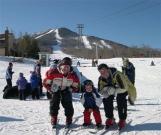1
Early builders: Mont Saint-SauveurMany skiers and businessmen were instrumental in making Saint-Sauveur a favourite spot for skiing. I can't mention them all, but I will introduce you to three I knew well: Victor Nymark, Per Hall and Jacques Hébert.
2
Hill 70 and the new Nymark Lodge20th Century, around 1938
Saint-Sauveur (Québec)
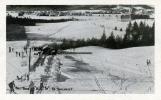 Credits:
Credits:Laurentian Ski Museum
3
Jackrabbit honoured at St. Francis of the Birds church20th Century, 1977
Saint-Sauveur (Québec)
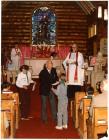 Credits:
Credits:Laurentian Ski Museum
4
Victor NymarkVictor Nymark
An energetic and enterprising man, Victor Nymark is counted among the pioneers of the Mont Saint-Sauveur ski centre. In fact, it is thanks to him that this mountain was developed.
In 1930 he bought lots 251 and 252 where he built a house and farm buildings and grew vegetables to sell to visitors. With the aim of improving access to his farm, he extended rue Saint-Denis. And, so he could offer beds to skiers, he enlarged his house. In 1933, he teamed up with Adolphe Bélanger to create the Saint-Sauveur Sports Club (which became the Saint-Sauveur Ski Club) and erect a ski jump. Then in 1934 he opened the first ski shop in the area.
Starting in March 1935, the club organized a week of competitions and festivities, an annual event that helped make our region better known among Montrealers. if young people - and others - now enjoy a week off in early March, they might want to thank Victor Nymark, who helped start the tradition.
Victor Nymark was also a builder and constructed or helped construct many buildings in the Scandinavian log style, including Nymark Lodge (seen under construction in the 1939 photo of Saint-Sauveur) and the Chateau Montebello. In fact he left a heritage of nearly 50 typical log structures that mark the Laurentian landscape, among them St. Francis of the Birds, the Anglican church in Saint-Sauveur.
In 1960, Victor Nymark founded the nine-hole Saint-Sauveur Golf Club at the foot of Hill 70. He died in 1983 and is buried in the St. Francis of the Birds cemetery.
5
A map from the Sweet Caporal's skier's book20th Century, 1940
Saint-Sauveur (Québec)
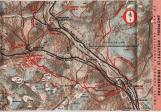 Credits:
Credits:Laurentian Ski Museum
6
From the station to Nymark Lodge20th Century, 1948
Saint-Sauveur (Québec)
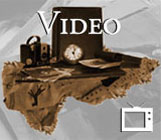 Credits:
Credits:Canadian National, ONF 1948
7
At the top of Mont Saint-Sauveur20th Century, 1950
Saint-Sauveur (Québec)
 Credits:
Credits:Laurentian Ski Museum
8
Per HallPer Hall
Per Hall also ranks high among those who contributed to Mont Saint-Sauveur's growing fame as an important ski centre. Originally from Denmark, Per Hall came to Canada to complete a doctorate at the University of Toronto. When Denmark was invaded by Germany, he decided to settle here.
During the war years, he spent much time on the ski trails of the Laurentians where he became friends with Mark and Joanne Farrell. The three of them talked about developing a modern ski centre.
At the end of the war, Per Hall and the Farrells formed the company Up-Hill Ltd. and set about looking for the best spot to invest in a ski hill. After several visits to the Laurentians, they settled on Saint-Sauveur. As well as being served by two railway lines and a good road, the village had hotels and pensions that could accommodate more than 700 visitors. And Saint-Sauveur was already known for Hills 69, 70 and 71, which were equipped with rope tows, and for the slope at La Maquise with its T-bar and two rope tows.
Per Hall and his colleagues contacted Constam & Co., a Swiss manufacturer of mechanical lifts, and approached the Charette family, then owners of Hills 70 and 71. But Arthur Charette had just signed an offer to purchase with Victor Nymark. So, on October 10, 1945, Per Hall and colleagues met Victor and agreed to rent space to install a T-bar mid-way between Hills 70 and 71. This lift started running December 6, 1946. Ten years later, another T-bar was installed to the east of Hill 70.
Back in 1946, we skied on natural snow. Any "grooming" was thanks to young people who herringboned up the hill to pack the snow - in exchange for free skiing. I didn't have money to pay for lifts so I was part of that group. In 1956 Up-Hill bought a Tucker grooming machine to replace the young people - so we can definitely say that Per Hall contributed to improved ski conditions.
9
Group of skiers at top Mont Saint-Sauveur20th Century, around 1948
Saint-Sauveur (Québec)
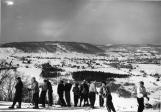 Credits:
Credits:Laurentian Ski Museum
10
Jacques HébertJacques Hébert
In 1969, a group of young skiers led by Jacques Hébert and Guy Piché bought 40 per cent of Up-Hill's shares. And in 1973 Victor Nymark sold them Hills 70, 71 and 72. Later during the summer, Jacques Hébert and his associates bought Hill 68. Hill 67 became a road that now has condos on it.
Thanks to Jacques Hébert's efforts, the various properties were united under a single entity. He convinced the owners to sell a part of their interests to the ski centre to be managed by a newly formed group including Hébert, Paquette, Lévesque, Lavoie, Couture, Dufour et Piché. By gradually purchasing parcels of land, the company went from being a tenant to an owner - and the harmonious development of the centre was underway.
The new company was called Mont Saint-Sauveur International and went on to become one of the most prosperous ski areas in the Laurentians.
Other key events followed. In 1976, we saw the first night skiing. In 1978, a fire destroyed the Nymark Lodge. A water park opened in 1986. In 1997, the ski areas of Mont Saint-Sauveur, Mont Avila, Ski Morin-Heights, Ski Mont Gabriel and Mont Olympia were grouped under the banner "Stations de la Vallée de Saint-Sauveur inc". Snowboard runs and parks - now widely known and home to several Canadian championships - attract new clientele and have added plenty of excitement to the centre.
